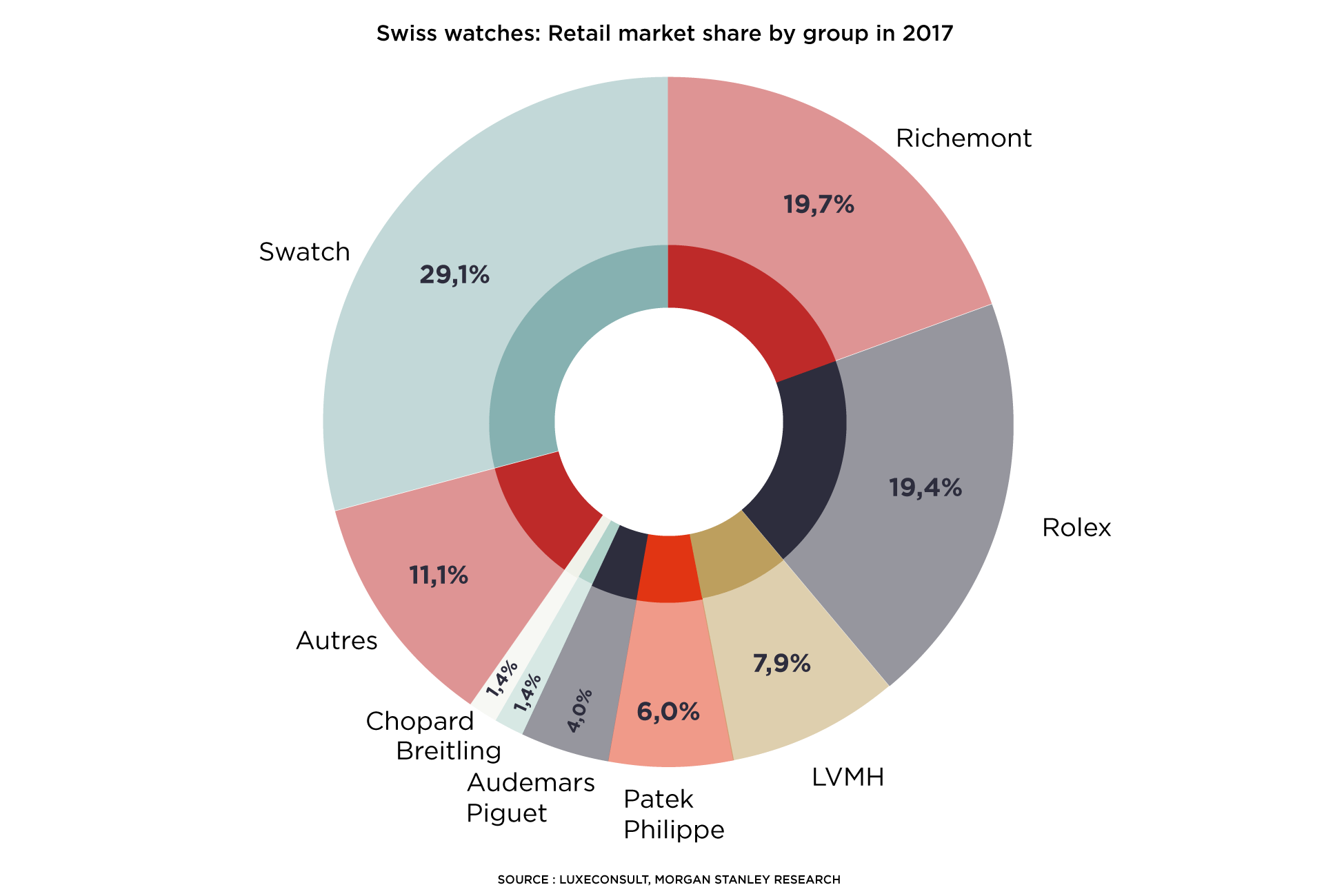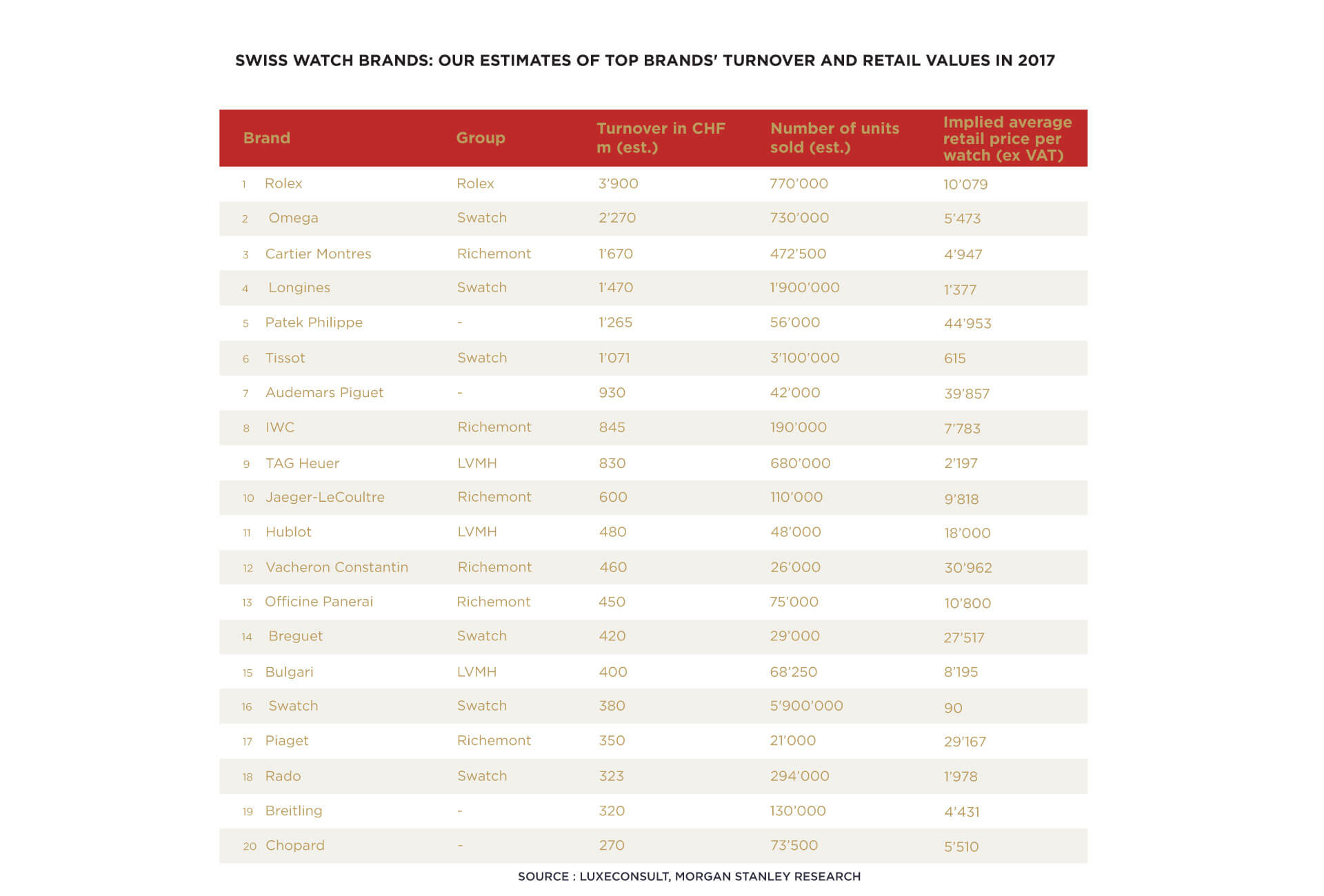Until now, Vontobel was the only financial institute to produce an annual report on the Swiss watch industry. The results of the bank’s findings are scrutinized by industry insiders and outside observers alike, in search of figures that brands generally like to keep well-hidden – in particular turnover and annual production. Since April this year, another bank – Morgan Stanley, working with LuxeConsult – has also been taking a close interest in the sector and producing its own estimates.
Six billionaires
The American investment bank begins its portrait of the industry with an analysis of market share: “As per our estimates, out of ~350 brands in Switzerland, only six brands posted turnover exceeding CHF 1bn in 2017: Rolex, Omega, Cartier, Longines, Patek Philippe and Tissot. With sales up +9% YoY in 1Q18, Audemars Piguet crossed the CHF 1bn threshold on a 12-month rolling basis only at the end of March 2018, as per CEO Bennahmias”. The report then elaborates on individual brands’ turnover, starting with Rolex whose 2017 net sales are estimated at CHF 3.9 billion for 770,000 watches sold (Vontobel estimates Rolex’s 2016 sales at CHF 4.9 billion, one of several differences between the two analyses). Add the CHF 230 million turnover of sister brand Tudor, and the industry’s biggest player takes a 19.4% share of the market.
Second place on the podium goes to Omega with estimated sales of CHF 2.27 billion for 730,000 units. Its annual production creeps closer to that of Rolex each year, although average price per unit is almost half that of its main competitor. Cartier ranks third with CHF 1.7 billion for 472,500 units sold. As Morgan Stanley observes, the brand’s watch sales have been under pressure in recent years, resulting in inventory buyback in 2017, going on to note that the share of watches in Cartier’s sales mix has declined from 50% in 2012 to 30% in 2017. The appointment of Cyrille Vigneron as CEO and a shift in strategy, focusing the brand on elegant form watches and ladies’ watches, are helping to reverse that trend. Morgan Stanley estimates Cartier’s share of the Swiss watch market at 5.6%. Completing the top-six line-up are Longines (CHF 1.47 billion for 1.9 million units sold), Patek Philippe (CHF 1.3 billion for 56,000 units sold) and Tissot (CHF 1.1 billion for 3.1 million units sold).
Privately-owned brands come out top
These initial estimates show a relatively consolidated industry dominated by a handful of multinationals. With total sales estimated at CHF 42 billion, the four largest groups of Swatch, Richemont, Rolex and LVMH account for more than 75% of the retail market for Swiss watches or, in decreasing order, 29.1% for Swatch Group, 19.7% for Richemont, 19.4% for Rolex and 7.9% for LVMH. Morgan Stanley makes several interesting remarks, starting with Swatch Group’s increased reliance on star brands Omega, Longines and Tissot. They provide more than 60% of its turnover and an even larger share of profits. Consequently, “out of Swatch Group’s 19 watch brands in total, a few have now become relatively immaterial to Group sales and profits”; these include two former high-flyers, Swatch and Breguet. Richemont, in contrast, is less dependent on its “mega brands” though failed to benefit from the rebound that began in the second half of 2017. Of the 13 brands in its portfolio, only Cartier exceeds CHF 1bn in turnover. Brands such as IWC and Panerai have performed well these past years, while other big names such as Jaeger-LeCoultre and Vacheron Constantin have found it harder to stay the pace.
So who is top and bottom of the class? Congratulations are in order for privately-owned brands Rolex, Patek Philippe and Audemars Piguet, which together post a 30% market share. According to Morgan Stanley, “these brands are vertically integrated upstream, managed for the long term (e.g. zero tolerance for grey market practices) and are going from strength to strength.” Still to make the grade is Kering: aggregate sales for Ulysse Nardin, Girard-Perregaux and JeanRichard scraped in at CHF 190 million in 2017. Kering’s market share stood at less than 1%, half what it was in 2014 when it bought Ulysse Nardin. Hermès is another straggler. It reported watch sales of CHF 175 million in 2017, down from the peak in 2012 despite efforts made by the company.













